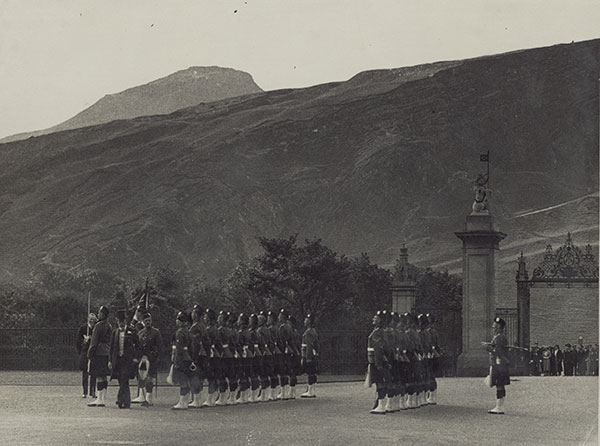After the First World War, Lisalie Armstrong met and fell in love with Major Odo Russell of the Black Watch, a Scottish Highland regiment. They were married in London on 8 June 1927. The wedding generated much interest, not least because the couple were led from the church by a Black Watch piper. Lisalie’s wedding bouquet contained flowers brought from Arras in memory of her brother.
Lisalie and Odo lived in Broadmead Manor, an eighteenth-century red brick house on the outskirts of Folkestone. Odo retired from the army in 1936, but re-joined his regiment when the Second World War broke out, and was sent to France with the British Expeditionary Force in the first week of October 1939. He was taken prisoner in Saint-Valery-en-Caux in Normandy on 12 June 1940, when the 51st Highland Division, fighting a defensive battle, were forced to surrender to Erwin Rommel. Although wounded in the shoulder by a mortar shell, he was forced to walk 250 miles across Northern France, Belgium, and Holland into Germany. His first prison camp was located in Bavaria, not far from Hitler’s retreat in Berchtesgaden. After a few months he was transferred to Warburg and finally to Spangenberg Castle, a moated medieval fortification in North Hesse.
Conditions in the prison camp were not good, and they deteriorated further as the war progressed. Food rations consisted of weak soup, potatoes, and black bread and provided a bare subsistence. Without the aid of Red Cross parcels, and a small patch of ground on which vegetables could be grown, many prisoners would have perished. Although they were not forced to work, parties regularly went out to cut firewood to keep warm as the German fuel rations had almost failed. The prisoners’ only contact with the outside world was a wireless radio, which they had managed to smuggle from Warburg by hiding it inside a piano. In Spangenberg, it was hidden under the floorboards of an upstairs room. Two shorthand writers, equipped with earphones obtained from the black market, listened to the news from England every evening. Odo and five other men then wrote out the bulletins in longhand and read them out to other prisoners late at night.
On 28 March 1945, American troops reached within 15 miles of Spangenberg. The Germans moved the captives out in a hurry and over the next three days marched them 49 miles to Langenfeld. By this time, the German guards were desirous of surrendering, and permitted the men to telephone through to a village ten miles back, where American troops were located. Initially, the officers did not take seriously the claim that 250 British prisoners were close by waiting to be rescued. Eventually however the tanks rolled in and were greeted by a crowd of elated but exhausted men. Odo returned to England in April 1945, having in the last eight months alone lost three stone of his bodyweight.
After the war, Lisalie and Odo spent much time visiting Ione in Leicester and spending long holidays in Ireland at Moyaliffe Castle and Ballinacor, the homes of Lisalie’s sister Jess and her husband William Kemmis. They had no children.
Odo Russell died in Folkestone on 19 January 1980, aged 80. Lisalie remained at Broadmead Manor until her own death on 13 May 1990 at the advanced age of 93. She was the last surviving member of the Armstrong family of Moyaliffe Castle, having outlived her brother Pat by ten days short of 73 years.


